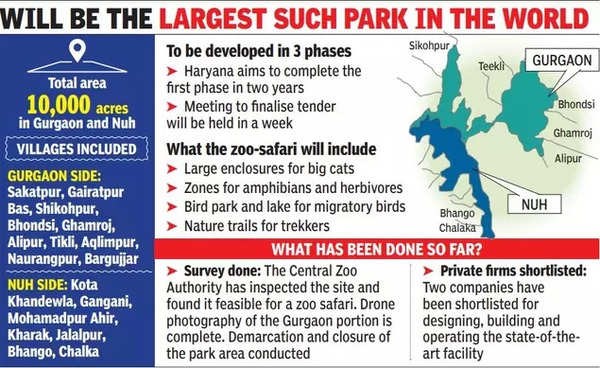Aravali Safari Park: Conservation Concerns Over Mega Project
Why in the news?
The Haryana government’s proposed 3,858-hectare Aravali Safari Park faces opposition from retired forest officers, citing ecological threats. They argue that the project prioritizes tourism over conservation, risking groundwater depletion, biodiversity loss, and legal violations in the Aravali hills.
About the Project:
- The Haryana government has proposed a 3,858-hectare Aravali Safari Park spanning Gurugram and Nuh
- The project aims to be the world’s largest safari park and was a BJP poll promise in Haryana.
- As per the Haryana Tourism Department’s tender, the park will include animal enclosures, guest houses, hotels, restaurants, auditoriums, an animal hospital, children’s parks, botanical gardens, aquariums, cable cars, tunnel walks, an open-air theatre, and eateries.
- Of the total land, 2,574 hectares will be in 11 villages of Gurugram and 1,284 hectares across seven villages in Nuh.
Opposition to the Project:
- The Aravali Hills, one of the oldest mountain ranges, plays a vital role in preventing desertification and recharging groundwater.
- 37 retired Indian Forest Service officers have urged Prime Minister Narendra Modi to cancel the project, arguing that it prioritizes tourism over conservation.
- Concerns include increased footfall, vehicular traffic, and construction, which could harm aquifers essential for groundwater in Gurugram and Nuh.
- The project area is categorized as “forest” under the Forest Conservation Act, 1980, and Haryana already has a low forest cover (3.6%), requiring rewilding rather than commercial projects.
Legal Protections for Aravali:
- Most of the 80,000-hectare Aravali range in Haryana is protected by laws and court rulings.
- The Punjab Land Preservation Act (PLPA), 1900, restricts land use changes in the hills.
- The Supreme Court’s T.N. Godavarman (1996) judgment extends legal protection to all forests as per the dictionary definition.
- The National Capital Region’s Regional Plan-2021 designates the Aravali range as a Natural Conservation Zone, limiting construction to 5%.
- Experts suggest declaring a national park or sanctuary instead of developing a safari park.
About Eco-Sensitive Zones (ESZs):
- The National Wildlife Action Plan (2002-2016) mandates state governments to declare land within 10 km of national parks and wildlife sanctuaries as Eco-Sensitive Zones (ESZs) under the Environmental (Protection) Act, 1986.
- While the 10-km rule is a general guideline, areas beyond this limit can also be declared ESZs if they serve as ecologically important corridors.
Aravali Mountain Range:
- One of the oldest fold mountains, now residual mountains, with elevations ranging from 300m to 900m.
- Extends ~720 km from Himmatnagar (Gujarat) to Delhi, Haryana, and Rajasthan.
- Divided into two main ranges: Sambhar Sirohi Range and Sambhar Khetri Range (~560 km in Rajasthan).
- The hidden limb extends from Delhi to Haridwar, dividing the Ganga and Indus river drainage.
- Formed by orogenic movement due to the collision of the pre-Indian subcontinent with Eurasia.
- Carbon dating reveals mining of copper and other metals in the Aravallis dates back to the 5th century BC.




